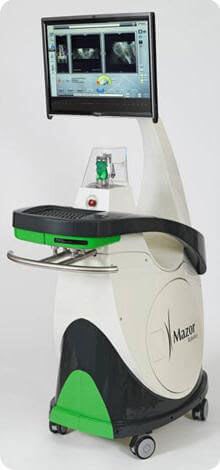Robotic spine Surgical Systems transforms spine surgery from freehand procedures to highly-accurate, state-of-the-art robotic procedures, with less radiation and is used for procedures including minimally invasive surgery (MIS), scoliosis, and other complex spinal deformities. It is a minimally invasive robotic guided spine surgery system.
Why Robotics?

Robotic minimally-invasive surgeries are moving from the laboratory to the surgical suite after a long period of testing and validation. In selected patients they can help the Spine Specialist with more accurate implant placement and sagittal balance restoration states Dr Prem Pillay. World wide robotic assisted spine surgery has been used to successfully performed a wide range of procedures ranging from complex reconstructions on childhood deformities to minimally invasive surgeries for low back disorders.
Clinical Applications
This system can be used for a variety of clinical procedures including :
- Open, MIS [Minimally invasive], and percutaneous posterior thoracolumbar approaches
- Scoliosis and other complex spinal deformities
- Pedicle screws – short and long fusions
- Transfacet screws and translaminar-facet screws
- Osteotomies
- Biopsies
- Sagittal Balance Restoration and correction
Advantages
- Higher accuracy
- Less radiation
- Fast learning curve

Conventional, freehand MIS presents many challenges. According to literature, in freehand surgery there are instances of misplaced pedicle screws and high levels of radiation are required for intraoperative imaging to assure accuracy. Spinal Robotics’ state-of-the-art technology overcomes these challenges thus redefining the standard of care for MIS.
Spinal Robotics Technology has been successfully used in the placement of over 20,000 implants in the United States and Europe. Numerous peer-reviewed publications and presentations at leading scientific conferences have validated the accuracy, usability, and its clinical advantages.